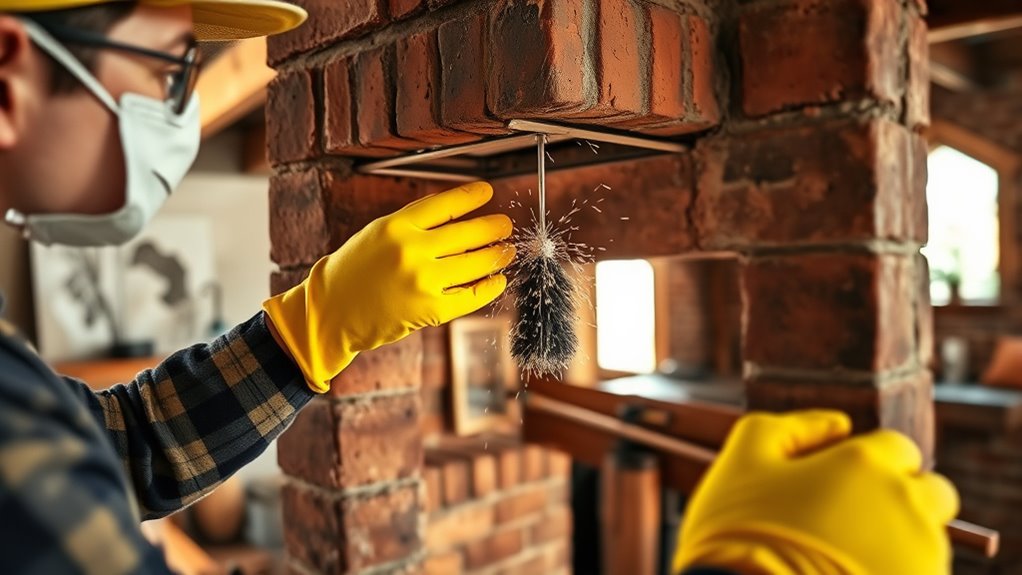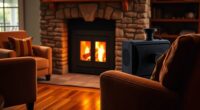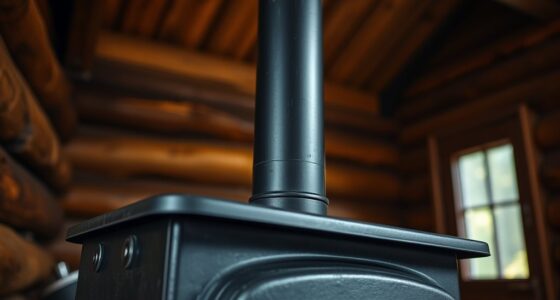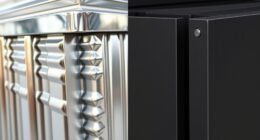You should sweep your chimney at least once a year to prevent dangerous creosote buildup, reduce fire risks, and keep your heating system running safely. How often you need to clean it more depends on how often you burn wood, the type of wood used, and your chimney’s condition. Regular inspections help spot the early signs of buildup. Keep going to discover more tips to keep your chimney safe and efficient year-round.
Key Takeaways
- Inspect your chimney at least once a year to check for creosote buildup and potential hazards.
- Sweep more frequently if you burn wood regularly or use unseasoned or hardwood.
- Consider cleaning every 3 to 6 months during heavy use or the heating season.
- Use visual signs like shiny or tar-like deposits to determine if cleaning is needed sooner.
- Regular maintenance ensures safety, improves efficiency, and prolongs chimney lifespan.

If you regularly burn wood in your fireplace or stove, sweeping your chimney is essential for safety and efficiency. One of the key reasons to stay on top of chimney maintenance is to prevent creosote buildup, which can become a serious fire hazard. Creosote is a dark, tar-like substance that accumulates on the interior walls of your chimney as a byproduct of burning wood. Over time, it can build up to dangerous levels if not removed, increasing the risk of chimney fires. Conducting a thorough chimney inspection at least once a year helps you identify creosote buildup early and decide if a cleaning is needed. If you notice a thick, shiny, or tar-like substance during your inspection, it’s time to call a professional to sweep your chimney.
The frequency of sweeping depends largely on how often you burn wood and the type of wood you use. If you’re a casual burner, perhaps burning a few times during the winter, you might only need to sweep once annually. However, if you burn wood frequently or use seasoned hardwood, you’ll want to contemplate more regular cleanings—perhaps every 3 to 6 months during the heating season. The goal is to keep creosote levels low enough to warrant any chance of ignition. A professional chimney sweep can assess the buildup during an inspection and remove any dangerous deposits efficiently. Additionally, proper airflow can help reduce creosote buildup, making regular cleanings less frequent. Ensuring adequate ventilation can also improve combustion efficiency, reducing creosote formation. Maintaining a clean chimney not only enhances safety but also prolongs the lifespan of your chimney system. Regular maintenance also helps prevent structural damage, which can be costly to repair.
Ignoring regular chimney inspections and cleanings can have serious consequences. Excess creosote buildup doesn’t just pose a fire risk; it can also restrict airflow, reducing your stove’s efficiency and causing smoke backdrafts into your home. This buildup can also contribute to indoor air pollution, which is unhealthy for you and your family. By staying proactive with inspections and sweeps, you keep your chimney functioning properly, ensuring safe and efficient operation. Remember, even if you don’t notice any visible issues, creosote can be present in hidden areas, so routine inspections are indispensable.
Frequently Asked Questions
Can I Sweep My Chimney Myself Safely?
Yes, you can sweep your chimney yourself safely if you follow chimney safety guidelines and DIY cleaning tips. Start by inspecting the chimney for blockages and creosote buildup, then wear protective gear like goggles and a mask. Use a proper chimney brush and secure a sturdy ladder. However, if you’re unsure or notice significant damage, it’s best to hire a professional to avoid risks and guarantee thorough cleaning.
What Signs Indicate My Chimney Needs Sweeping?
You’ll notice a dark, tar-like film lining your chimney, signaling creosote buildup that needs addressing. If animals leave behind nests or chatter nearby, it’s a clear sign of intrusion. Smoke may also back up into your home or your fire’s flames flicker unevenly. These signs point to the need for a sweep, ensuring your chimney remains safe and efficient—don’t ignore these quiet hints.
How Does Chimney Type Affect Cleaning Frequency?
The type of chimney, including its material and venting system, directly impacts how often you should clean it. Metal chimneys typically need less frequent sweeping, while masonry ones may require more regular maintenance due to creosote buildup. If your venting system is complex or has multiple bends, it’s best to inspect and sweep more often to prevent blockages and ensure safe operation. Regular checks help you determine the right cleaning schedule for your chimney type.
Does Weather Impact How Often I Should Sweep?
Think of your chimney as a guardian protecting your home. Weather heavily impacts how often you need to sweep it—harsh storms or damp conditions can cause more creosote buildup and soot, requiring more frequent cleanings. To guarantee chimney safety, use proper cleaning tools, especially after severe weather, and inspect regularly. Adapting your cleaning schedule to weather conditions keeps your chimney efficient and safe, safeguarding your home and loved ones.
Are There Seasonal Considerations for Chimney Maintenance?
Seasonal considerations play a big role in chimney maintenance. You should schedule a chimney inspection before winter to verify proper venting efficiency and safety during heavy use. After the heating season, consider a cleaning to remove creosote buildup and check for any damage. In spring and fall, regular inspections help maintain peak performance and prevent hazards. Staying proactive ensures your chimney remains safe and efficient throughout the year.
Conclusion
Remember, a clean chimney keeps your home safe and cozy. Generally, you should sweep it once a year, or more often if you use it heavily. Don’t wait until you see smoke or smell creosote—regular maintenance prevents bigger problems. As the saying goes, “A stitch in time saves nine.” Stay proactive with chimney care, and you’ll enjoy warm fires without worry all season long.











